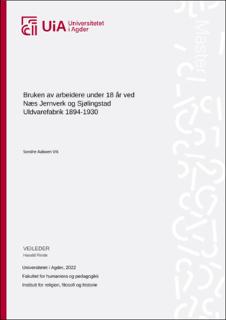| dc.description.abstract | This master's thesis examines the use of child and adolescent laborers under the age of 18 at
Næs Jernverk and Sjølingstad Uldvarefabrik between the years 1894 and 1930. The primary
research questions addressed in this study are: "How were children utilized as laborers?"
focusing on the extent of child labor, their assigned tasks, wages, working hours, and their
connection to the paternalistic companies. The second main research question is: "How did
the utilization of child labor decline and why?" This is further explored through the subquestion: "Did schooling replace child labor, and if so, how did this occur?" The study
investigates the decline in child labor at the two companies during the 1920s and attempts
to identify the reasons behind this decline.
The children and their parents, as employees of the companies, were closely tied to the
establishments as their lives revolved around them. Many parents had debts to the
companies from purchasing goods or taking loans, which made them economically bound.
Additionally, many resided in company-owned or provided housing. The children were
assigned work that was considered "suitable for children." At the ironworks, children
typically began working at an early age, some as young as 8 years old, while at Sjølingstad,
they were slightly older. Work at Sjølingstad was gender-segregated, with certain jobs
reserved for girls, whereas only boys worked at Næs. Both companies had apprentices, with
the majority being at the ironworks, while all apprentices at the woolen mill were boys. They
worked ten hours a day until the introduction of an eight-hour workday in 1919. Over time,
the utilization of child labor decreased, with Næs Jernverk having more child labor until
1915, after which only a few children worked. Sjølingstad still employed child labor, albeit
for fewer hours. The decrease in child labor was not due to a high turnover of workers but
the development of the education system might explain the change. Schools began to play a
greater role, introducing new subjects, becoming more pedagogical and enlightening. The
perception of children remained unchanged, but the understanding and expectations
shifted, leading to a greater awareness of child labor as a negative practice. A battle was
fought against the government when municipalities sought to gain more control over or take
over company schools. Næs Jernverk's company school was eventually taken over by the
municipality in 1922. Little research has been conducted on child labor at these two
companies, particularly at Næs Jernverk during the specific period under investigation | |
